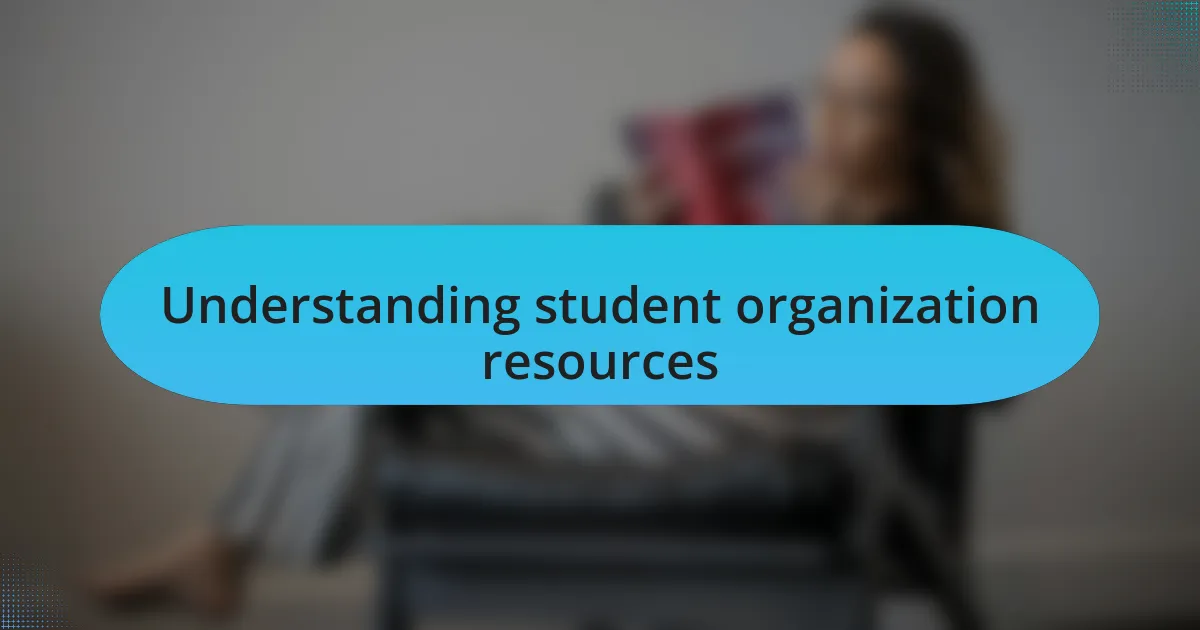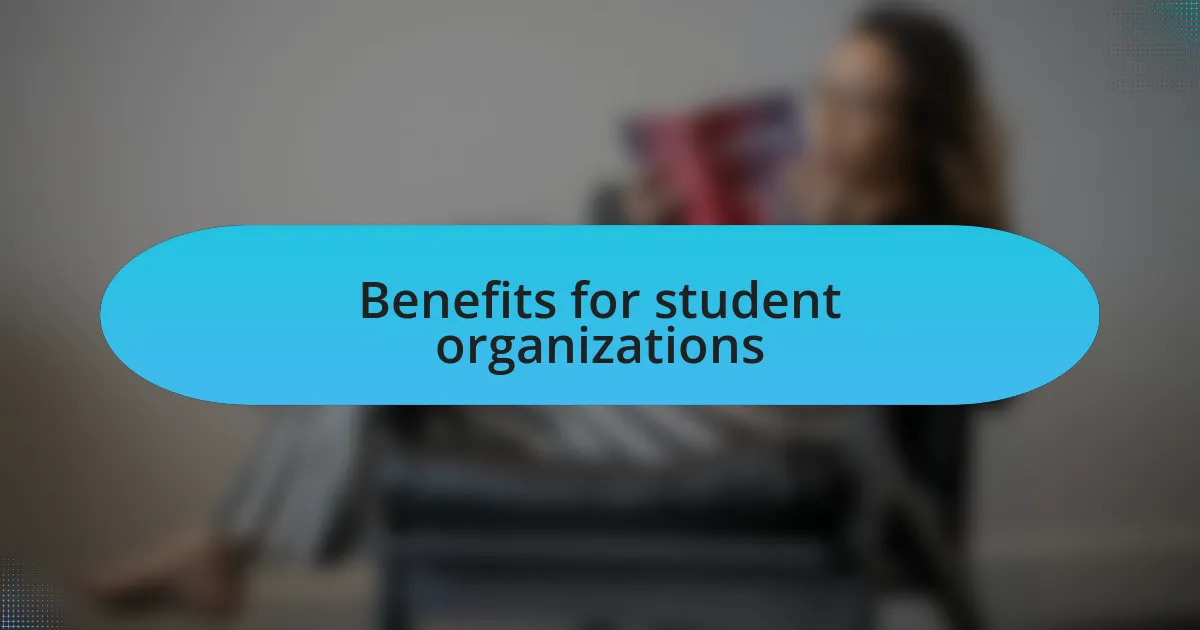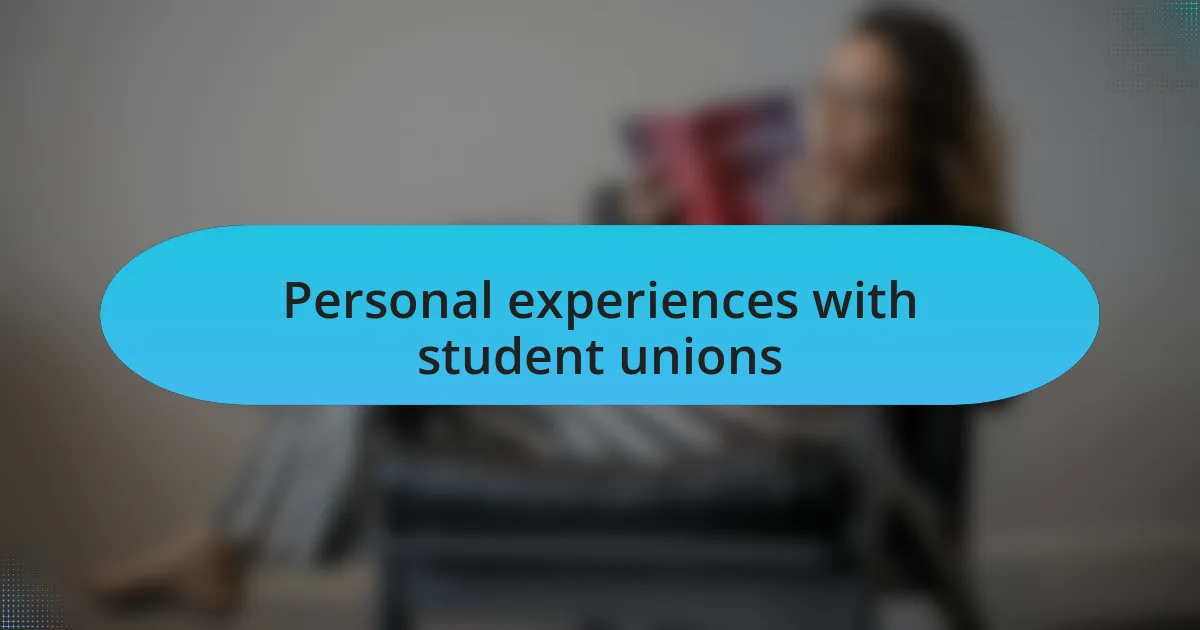Key takeaways:
- Understanding student organization resources is crucial for enhancing campus life and fostering community building.
- Student unions play a vital role in advocating for student needs, providing leadership opportunities, and supporting academic success.
- Collaborating with other organizations and setting clear goals are essential strategies for maximizing resource use in student organizations.
- Leveraging technology and seeking member feedback can significantly enhance organizational effectiveness and engagement.

Understanding student organization resources
Understanding the resources available for student organizations is essential for fostering a thriving campus life. I remember joining my first club and feeling overwhelmed by the myriad of options at my disposal. It struck me how each resource could serve as a lifeline for new members, making it easier to navigate the complexities of college life.
Student organization resources encompass a wide range of support systems, from funding to mentorship. I once attended a workshop that detailed the grants available for different events, and it was an eye-opener. Have you ever considered how these financial resources could transform your organization’s ability to host events or invite speakers? For me, that realization was empowering; it sparked creativity and initiative within our group.
Moreover, networking opportunities offered through these resources can lead to lasting connections. I can recall meeting upperclassmen who previously held the same roles I was stepping into. Their advice was invaluable, reminding me that these resources aren’t just tools—they’re gateways to community building. Isn’t it exciting to think about how such interactions can shape our experiences and broaden our horizons on campus?

Importance of student unions
Student unions play a vital role in enhancing the college experience for all students. I remember my first encounter with the student union during orientation; it was like stepping into a hub of activity and excitement. That moment was pivotal as I realized this space was dedicated to advocating for student needs and interests, creating a sense of community that I soon came to cherish.
Moreover, student unions often serve as the backbone for student leadership and representation. I was fortunate to participate in a town hall meeting organized by the union, where students could voice their concerns directly to campus administration. This forum made me appreciate how the union acted as a bridge between students and the administration, promoting transparency and dialogue. Have you ever felt empowered by having a platform to express your thoughts? When I shared my perspective, I felt heard, which is a rare and important experience in any educational setting.
Finally, the support provided by student unions can significantly impact academic success. Looking back, I remember attending several workshops hosted by the union that focused on study skills and exam preparation. Those sessions not only improved my grades but also eliminated much of the stress I faced during finals. Can you imagine what your academic journey would look like with such support readily available? The student union is more than a physical space; it’s a vital resource that nurtures personal growth and reinforces our collective spirit.

Types of resources offered
Student unions offer a diverse array of resources that cater to various student needs. For instance, I remember stumbling upon a resource center dedicated to providing personal and academic support. It served as a one-stop shop for tutoring services and mental health counseling, making it easier for students to seek help. The ease of accessing these resources played a crucial role in my journey, particularly during challenging periods when I needed someone to lean on.
Moreover, these organizations often host events that connect students with internships and job opportunities. I vividly recall a career fair organized by the student union, where I found potential employers who were genuinely interested in my background. It certainly sparked a fire within me, knowing there were tangible pathways to my future right there on campus. Have you participated in such events? It’s fascinating how these connections can reshape your career trajectory.
Lastly, student unions frequently provide funding and support for student organizations, allowing them to flourish on campus. I witnessed firsthand how my club benefited from this backing; we were able to organize events that sparked incredible conversations and engagement among peers. The financial assistance and logistical support provided made all the difference in bringing our ideas to life and fostering a vibrant campus culture. Isn’t it amazing how a little support can empower students to lead and create?

Benefits for student organizations
Student organizations enjoy numerous benefits that enhance their overall experience. One significant advantage is the opportunity to build a robust community. I remember joining a cultural club where the camaraderie was palpable. We shared ideas, celebrated our diverse backgrounds, and created lifelong friendships, which made my university experience more fulfilling. How often do we find a sense of belonging that enriches our daily lives?
Additionally, involvement in student organizations can significantly boost leadership skills. I took on a position in my club that pushed me out of my comfort zone, requiring me to plan events and coordinate with different stakeholders. It was challenging yet rewarding. This experience not only sharpened my organizational abilities but also taught me the importance of teamwork and communication. Have you considered how taking on such roles could impact your personal development?
Moreover, student organizations can strengthen resumes and provide practical experiences. When I applied for internships, highlighting my leadership role set me apart from other candidates. Employers often seek proof of initiative and collaboration, which these organizations inherently offer. Think about the last time you read a job description – did you notice how they all mention teamwork? Engaging in these groups can give you the edge you need to thrive in a competitive job market.

Personal experiences with student unions
When I first stepped into my university’s student union, it felt like entering a vibrant hub of creativity and collaboration. I remember wandering through the various booths during the organization fair, feeling that eager mix of excitement and nervousness. Each conversation sparked a new connection, igniting my passion for getting involved. Have you ever felt that rush of possibility when you realize how many opportunities surround you?
One of my most memorable moments came from attending a town hall meeting sponsored by the student union. There, I shared my thoughts on campus issues and discovered just how impactful a single voice can be when backed by a supportive community. The energy in the room was electric, and I marveled at how discussions could evolve into genuine change. It made me think—how often do we take for granted our ability to influence our environment?
Looking back, I see the student union as more than just a physical space; it was a launching pad for personal growth and advocacy. I recall the satisfaction I felt when my peers voted for initiatives I proposed. That experience cemented my belief in the power of collective action. Have you ever been part of a movement that changed your perspective? It truly reshaped how I view leadership and responsibility, reminding me that our shared efforts can pave the way for a brighter future.

Strategies for effective resource use
Effective resource use in student organizations can make all the difference in fostering a dynamic campus environment. I’ve seen firsthand how careful planning can maximize impact. For instance, collaborating with other organizations not only pools resources but also brings in diverse perspectives, allowing for more innovative programming. Have you ever partnered with another group? It can be a thrilling way to expand your reach.
One of the strategies I’ve found particularly useful is setting clear goals before initiating any project. It’s all too easy to get lost in the excitement of ideas, but by clearly defining what you hope to achieve, you can allocate resources more purposefully. I remember a time when my organization planned an event without a clear vision. The result was a disorganized effort that didn’t meet our expectations. Lesson learned—clarity is key. How well-defined are your goals?
Another thing that’s essential is to regularly evaluate the effectiveness of resource use. After completing a project, I make it a point to sit down with my team and discuss what worked and what didn’t. This reflection not only helps in refining future strategies but also inspires a culture of continuous improvement. Have you ever taken the time to assess your organization’s past efforts? Those discussions can spark new ideas and drive growth.

Recommendations for maximizing benefits
When it comes to maximizing the benefits of available resources, one approach I’ve found valuable is to leverage technology. For example, utilizing platforms like Trello or Slack has transformed how my team communicates and organizes projects. Have you experienced the chaos of juggling multiple tasks? Those tools can streamline your workflow, making it easier to stay on top of everything and enabling better collaboration.
Another recommendation is to actively seek feedback from your organization’s members. I remember asking my peers for their thoughts on a recent event we hosted; their insights not only highlighted areas for improvement but also made them feel valued and heard. How often do you collect input from your team? When members are engaged in decision-making, it fosters a sense of ownership that can lead to greater commitment and creativity.
Lastly, don’t underestimate the power of networking within the university’s student union. I’ve often found that just by attending events or workshops, connections can lead to unexpected collaborations and resource sharing. How well do you tap into those opportunities? These encounters can provide fresh ideas and open doors to partnerships that enhance your organization’s impact.